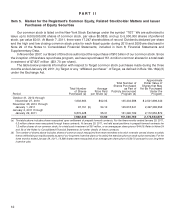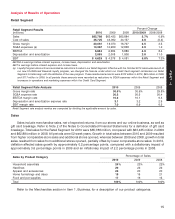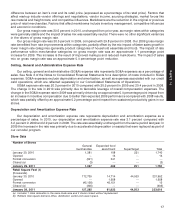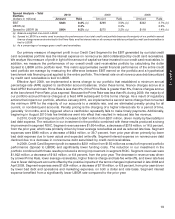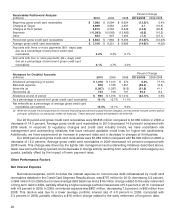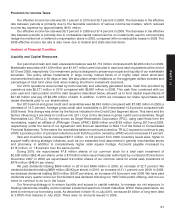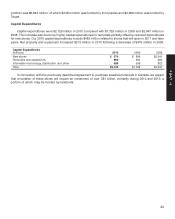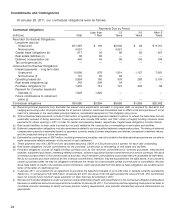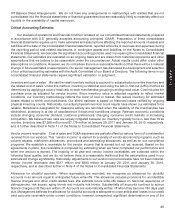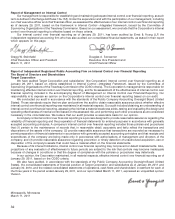Target 2010 Annual Report Download - page 44
Download and view the complete annual report
Please find page 44 of the 2010 Target annual report below. You can navigate through the pages in the report by either clicking on the pages listed below, or by using the keyword search tool below to find specific information within the annual report.
Our ability to access the long-term debt, commercial paper and securitized debt markets has provided ample
sources of liquidity to Target in the past. Our continued access to these markets depends on multiple factors
including the economic environment, our operating performance and maintaining strong debt ratings. The ratings
assigned to our debt by the credit rating agencies affect both the pricing and terms of any new financing. As of
January 29, 2011 our credit ratings were as follows:
Standard andCredit Ratings
Moody’s Poor’s Fitch
Long-term debt A2 A+ A
Commercial paper P-1 A-1 F1
Securitized receivables (a) Aa2 n/a n/a
(a) These rated securitized receivables exclude the interest in our credit card receivables sold to JPMC.
If our credit ratings were lowered, our ability to access the debt markets and our cost of funds for new debt
issuances could be adversely impacted. Each of the credit rating agencies reviews its rating periodically and there
is no guarantee our current credit rating will remain the same as described above.
As a measure of our financial condition we monitor our interest coverage ratio, representing the ratio of pretax
earnings before fixed charges to fixed charges. Fixed charges include interest expense and the interest portion of
rent expense. Our interest coverage ratio as calculated by the SEC’s applicable rules was 6.1x in 2010, 5.1x in 2009
and 4.3x in 2008.
At January 29, 2011 and January 30, 2010, there were no amounts outstanding under our commercial paper
program. In past years, we funded our peak sales season working capital needs through our commercial paper
program and then used the cash generated from that sales season to repay the commercial paper issued. In 2010
and 2009 we funded our working capital needs through internally generated funds and the long-term debt issuance
indicated above.
Commercial Paper
(millions) 2010 2009
Maximum daily amount outstanding during the year $— $112
Average amount outstanding during the year —1
Amount outstanding at year-end ——
Weighted average interest rate —0.2%
An additional source of liquidity is available to us through a committed $2 billion unsecured revolving credit
facility obtained through a group of banks in April 2007, which will expire in April 2012. No balances were
outstanding at any time during 2010 or 2009 under this facility.
Most of our long-term debt obligations contain covenants related to secured debt levels. In addition to a
secured debt level covenant, our credit facility also contains a debt leverage covenant. We are, and expect to
remain, in compliance with these covenants. Additionally, at January 29, 2011, no notes or debentures contained
provisions requiring acceleration of payment upon a debt rating downgrade, except that certain outstanding notes
allow the note holders to put the notes to us if within a matter of months of each other we experience both (i) a
change in control; and (ii) our long-term debt ratings are either reduced and the resulting rating is non-investment
grade, or our long-term debt ratings are placed on watch for possible reduction and those ratings are subsequently
reduced and the resulting rating is non-investment grade.
We believe our sources of liquidity will be adequate to maintain operations and to finance anticipated
expansion and strategic initiatives during 2011, including our plan to enter the Canadian retail market by paying
C$1,825 million to purchase the leasehold interests in up to 220 sites currently operated by Zellers Inc. We may
issue new long-term debt for these and other initiatives, and we anticipate ample access to long-term financing.
Further, in January 2011, we announced our plan to actively pursue the sale of our credit card receivables portfolio,
which may provide additional funding. As of January 29, 2011 the gross balance of our credit card receivables
22


